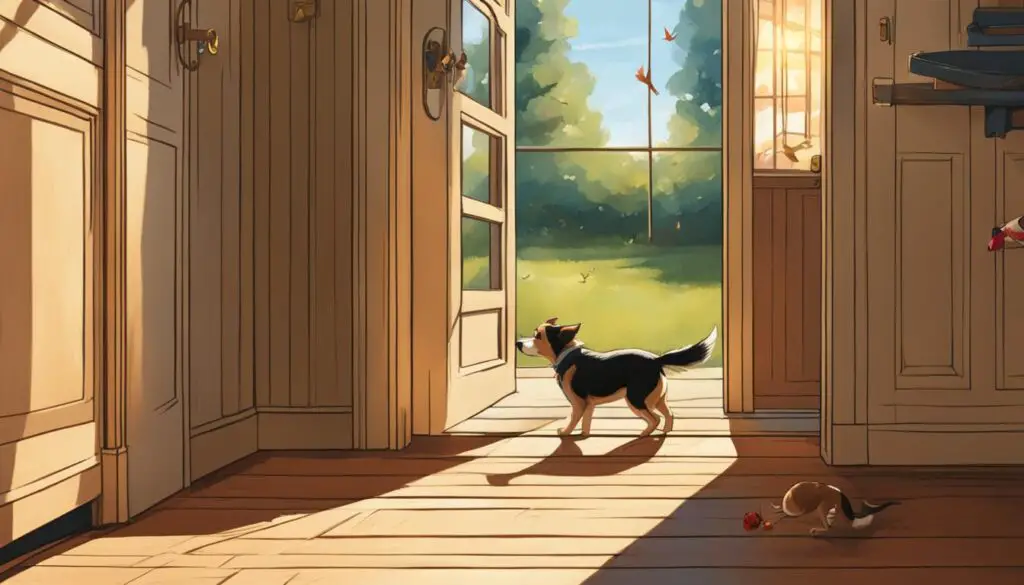Separation anxiety is a serious condition that can cause significant distress in small dogs when they are left alone. It is important to understand the causes and symptoms of this condition in order to effectively manage and alleviate it.
Small dogs with separation anxiety may exhibit behaviors such as excessive whining, barking, chewing, digging, and drooling. They may also have accidents indoors, even if they are housebroken. Some potential causes of separation anxiety in small dogs include being left alone for the first time, change in ownership or routine, moving to a new home, or the loss of a family member. Consulting with a veterinarian is crucial to rule out any underlying medical issues.
To help small dogs with separation anxiety, there are various treatment options available. These may include providing special treats, creating low-key entrances and exits, leaving clothing with the owner’s scent, and gradually acclimating the dog to being alone for longer periods of time.
Key Takeaways:
- Separation anxiety can cause distress in small dogs when they are left alone.
- Common symptoms of separation anxiety in small dogs include excessive whining, barking, chewing, and accidents indoors.
- Potential causes of separation anxiety include being left alone for the first time, changes in routine, moving to a new home, or the loss of a family member.
- Consulting with a veterinarian is important to rule out any underlying medical issues.
- Treatment options for small dogs with separation anxiety may include providing special treats, creating low-key entrances and exits, leaving clothing with the owner’s scent, and gradually acclimating the dog to being alone for longer periods of time.
Understanding the Symptoms and Causes of Separation Anxiety in Small Dogs
Small dogs with separation anxiety can exhibit a range of symptoms that indicate their distress when left alone. These symptoms include excessive vocalization (howling, barking, or whining), indoor accidents, destructive behaviors (chewing, digging, or scratching), excessive drooling or panting, pacing, and attempts to escape.
Separation anxiety in small dogs can be triggered by various factors, such as being left alone for the first time, changes in ownership or routine, moving to a new home, or the loss of a family member. It is important to identify the specific triggers for separation anxiety in order to address them effectively.
Common causes of separation anxiety in small dogs include being overly attached or dependent on their owners and experiencing significant stress when separated from them. It is also important to rule out other potential causes for the symptoms, such as medical issues or other behavior problems.
Symptoms and Causes of Separation Anxiety in Small Dogs
| Symptoms | Causes |
|---|---|
| Excessive vocalization (howling, barking, or whining) | Being left alone for the first time |
| Indoor accidents | Changes in ownership or routine |
| Destructive behaviors (chewing, digging, or scratching) | Moving to a new home |
| Excessive drooling or panting | Loss of a family member |
| Pacing | Being overly attached or dependent on owners |
| Attempts to escape | Significant stress when separated from owners |
Managing and Treating Separation Anxiety in Small Dogs
Managing and treating separation anxiety in small dogs requires a multi-faceted approach that combines behavior modification techniques and, in some cases, medication. By implementing these strategies, you can help alleviate your small dog’s distress and create a more positive experience when they are left alone.
Behavior Modification Techniques
One of the key aspects of managing separation anxiety in small dogs is behavior modification. This involves gradually desensitizing your dog to being alone and counterconditioning them to associate positive experiences with your departure. Here are some tips for effective behavior modification:
- Establish a predictable routine: Dogs thrive on routine, so try to establish a consistent schedule for their daily activities and alone time.
- Leave special treats or toys: Give your dog a special treat or toy that they only receive when you’re leaving. This creates a positive association with your departure.
- Practice low-key entrances and exits: Avoid making a big fuss when leaving or returning home. Stay calm and keep your greetings low-key to help your dog feel more relaxed.
- Gradually increase alone time: Start by leaving your dog alone for short periods and gradually increase the duration. This helps them build confidence and overcome their anxiety.
Medication and Remedies
In some cases, behavior modification alone may not be enough to manage your small dog’s separation anxiety. Your veterinarian may recommend medication or natural calming remedies to help alleviate their anxiety. Medication options for separation anxiety can include anti-anxiety medications or selective serotonin reuptake inhibitors (SSRIs) that help regulate mood and anxiety levels. Natural calming supplements, such as CBD oil or pheromone sprays, can also be considered as non-pharmaceutical alternatives.
Consultation and Professional Guidance
It’s important to consult with your veterinarian or a certified animal behaviorist when dealing with separation anxiety in small dogs. They can assess your dog’s specific needs and develop an individualized treatment plan that addresses their unique situation. Professional guidance and support throughout the process can be invaluable in helping your furry friend overcome their distress and build resilience.
Remember, managing separation anxiety takes time and patience. With consistent effort and the right techniques, you can help your small dog feel more secure and relaxed when they are left alone.
Dealing with Separation Anxiety in Small Dogs – Conclusion
Separation anxiety in small dogs is a challenging condition that requires understanding, patience, and the implementation of appropriate management and treatment techniques. By addressing the underlying causes, such as the dog’s attachment or dependence on their owner and the triggers for their anxiety, it is possible to alleviate their distress and help them feel more comfortable when left alone.
Behavior modification techniques, such as desensitization and counterconditioning, along with potential medication or natural calming supplements, can be effective in reducing the symptoms of separation anxiety. It is important to work closely with a veterinarian or certified animal behaviorist to develop an individualized treatment plan for your small dog.
With time, consistency, and proper care, small dogs with separation anxiety can learn to feel more secure and relaxed when their owners are not present.
FAQ
What are the symptoms of separation anxiety in small dogs?
Small dogs with separation anxiety may exhibit excessive vocalization (howling, barking, or whining), indoor accidents, destructive behaviors (chewing, digging, or scratching), excessive drooling or panting, pacing, and attempts to escape.
What are the potential causes of separation anxiety in small dogs?
Separation anxiety in small dogs can be triggered by factors such as being left alone for the first time, changes in ownership or routine, moving to a new home, or the loss of a family member.
How can separation anxiety in small dogs be managed and treated?
Managing and treating separation anxiety in small dogs involves behavior modification techniques such as desensitization and counterconditioning, along with potential medication or natural calming supplements. Consultation with a veterinarian or certified animal behaviorist is recommended.






No Comments